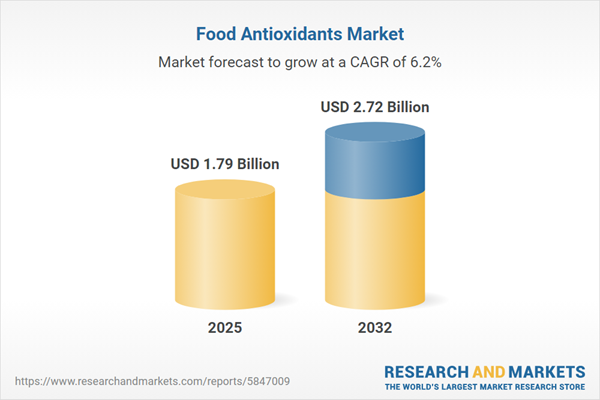Speak directly to the analyst to clarify any post sales queries you may have.
Senior leaders in the food sector are facing a landscape shaped by regulatory volatility, evolving consumer behaviors, and heightened expectations for supply chain agility. Steering through the complex food antioxidants market, executives must deploy strategies that drive compliance, accelerate innovation, and build operational resilience for the years ahead.
Market Snapshot: Food Antioxidants Market Size and Growth
The global food antioxidants market is currently valued at USD 1.68 billion and is forecast to grow to USD 1.79 billion by 2025, with an extended projection to reach USD 2.72 billion by 2032. Advancing at a CAGR of 6.15%, this market is driven by escalating demand for sophisticated antioxidant formulations in the food and beverage industry. Investment in advanced ingredient technologies and compliance strategies is intensifying. Key priorities now include leveraging innovative product development, enhancing shelf life, and aligning brand value with strict regulatory requirements and dynamic competition.
Scope & Segmentation
- Source: Covers both natural and synthetic antioxidant options, reflecting a growing emphasis on ingredient transparency and clean-label initiatives vital for procurement and new product launches.
- Form: Incorporates capsules, liquids, tablets, and powders, providing flexible applications and supporting efforts to meet demand for customization and innovation in product development.
- Application: Encompasses dietary supplements, cosmetics, pharmaceuticals, dairy, bakery, processed meats, sweets, confectionery, and frozen desserts, strengthening freshness and supporting competitive differentiation across diverse offerings.
- Ingredient Type: Includes ascorbic acid, carotenoids (such as beta-carotene, lutein, lycopene), polyphenols (both flavonoid and non-flavonoid), and tocopherols, each essential to maintaining product quality and acceptance in the marketplace.
- End Use Industry: Spans animal feed, beverage manufacturing, dairy processes, and the processed food sector, demonstrating the pivotal role antioxidants play in compliance and maintaining productivity across complex value chains.
- Regions: Encompasses the Americas, Europe, Middle East & Africa, and Asia-Pacific, with distinctive regional dynamics including regulatory priorities and consumer demand shifts in key markets such as the United States, Brazil, United Kingdom, China, India, and Japan.
- Leading Companies: Features benchmarking insights for organizations including Koninklijke DSM N.V., Archer-Daniels-Midland Company, BASF SE, DuPont de Nemours, Inc., Cargill, Kemin Industries, Lonza Group AG, Kalsec, Prinova Group, and AIDP, enabling informed evaluation of partners and competitors.
Key Takeaways: Strategic Insights for the Food Antioxidants Market
- Breakthroughs in extraction and formulation technology are enabling cleaner-label solutions that comply with an expanding set of global standards, enabling easier market entry and improved regulatory alignment.
- Innovative encapsulation and nanoemulsion techniques are broadening the application of antioxidants, facilitating increased stability and performance in processed and ready-to-eat food products.
- Greater transparency in the supply chain, paired with sustainable sourcing practices, is reducing operational risk and strengthening relationships with suppliers, which is vital for maintaining reliable, long-term networks.
- Regional shifts such as demand for traceability in the Americas, a compliance-driven focus in Europe, and logistics advances in Asia-Pacific are creating new pathways for growth and efficiency improvements.
- Digital transformation in supply chain management and vertical integration empowers manufacturers to adapt quickly to market shifts while minimizing disruptions in both procurement and production.
- Building agility through diversified sourcing and more flexible supplier networks equips organizations to address regulatory changes and market volatility across global operations.
Tariff Impact: Navigating New Cost Structures
Recent changes in U.S. tariffs are spurring manufacturers to reevaluate procurement tactics and boost domestic production capabilities. Focusing investments locally and realigning with suppliers less impacted by international trade issues are proving critical for managing uncertainty and optimizing cost structures amid ongoing tariff adjustments.
Methodology & Data Sources
This analysis is built on robust secondary research, executive interviews, and structured quantitative surveys. Together, these sources provide actionable, reliable guidance for leaders focusing on procurement, compliance, and strategy within the food antioxidants market.
Why This Report Matters
- Enables business executives to fine-tune segmentation and direct resources toward forward-looking antioxidant ingredient strategies aligned with sector trends.
- Supports compliance and procurement decision-makers in anticipating regulatory changes and building efficient, cross-regional supplier collaborations.
- Delivers competitive intelligence that strengthens organizational adaptability and supports efforts to achieve market distinction in complex operating environments.
Conclusion
Adopting data-centric and agile strategies allows organizations to navigate ongoing market transformation, foster operational efficiency, and strengthen resilience in the global food antioxidants landscape.
Additional Product Information:
- Purchase of this report includes 1 year online access with quarterly updates.
- This report can be updated on request. Please contact our Customer Experience team using the Ask a Question widget on our website.
Table of Contents
3. Executive Summary
4. Market Overview
7. Cumulative Impact of Artificial Intelligence 2025
Companies Mentioned
The companies profiled in this Food Antioxidants market report include:- Koninklijke DSM N.V.
- Archer-Daniels-Midland Company
- BASF SE
- DuPont de Nemours, Inc.
- Cargill, Incorporated
- Kemin Industries, Inc.
- Lonza Group AG
- Kalsec, Inc.
- Prinova Group LLC
- AIDP, Inc.
Table Information
| Report Attribute | Details |
|---|---|
| No. of Pages | 197 |
| Published | October 2025 |
| Forecast Period | 2025 - 2032 |
| Estimated Market Value ( USD | $ 1.79 Billion |
| Forecasted Market Value ( USD | $ 2.72 Billion |
| Compound Annual Growth Rate | 6.1% |
| Regions Covered | Global |
| No. of Companies Mentioned | 11 |









